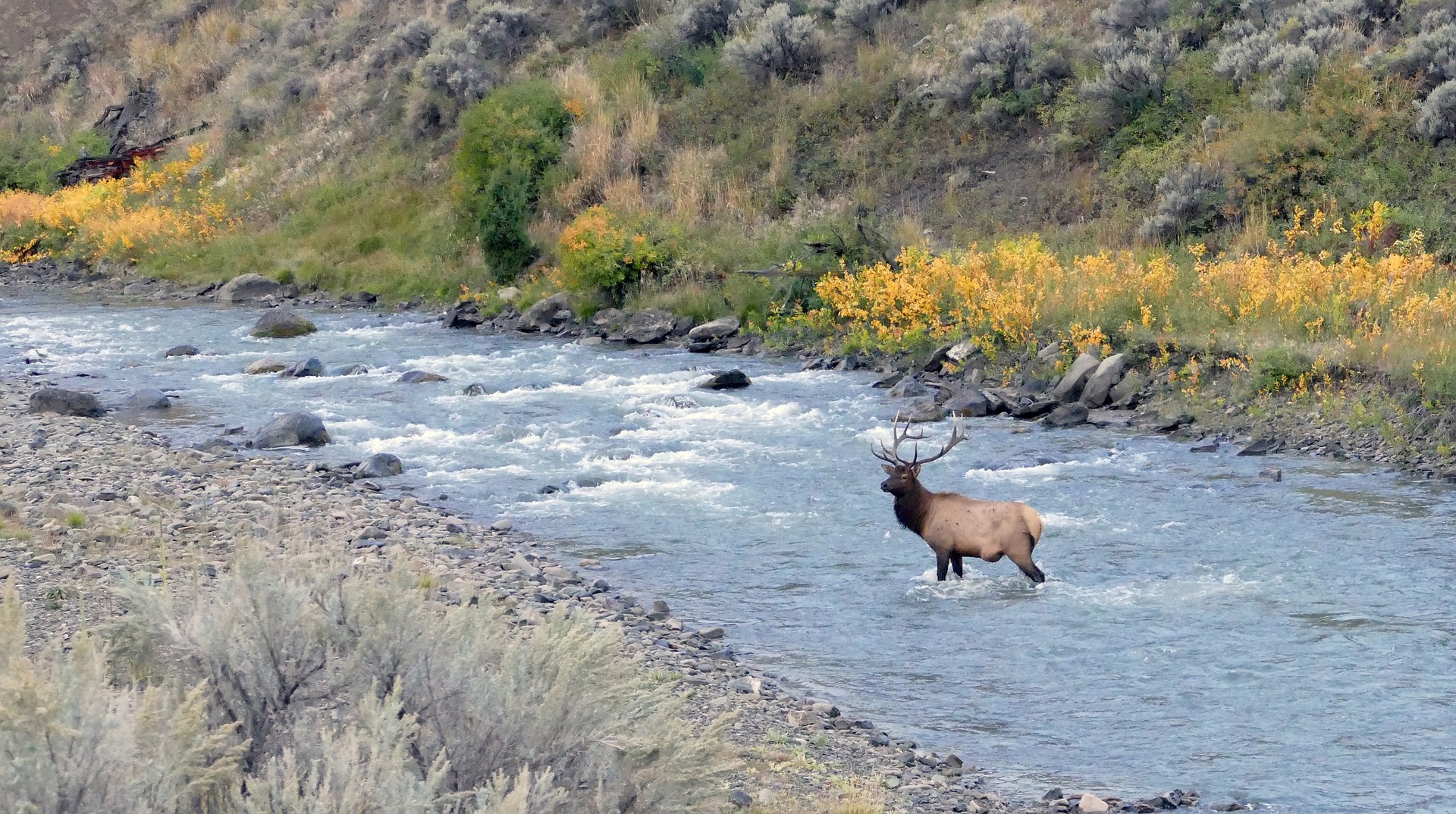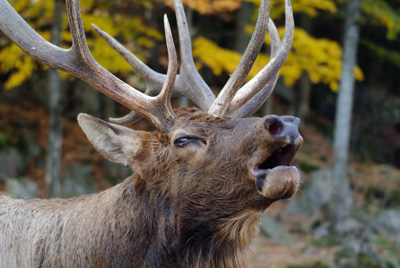Elk Shooting Range
How Far is Too Far?
Be prepared for that long shot before you are faced with the decision

“I wish he would shoot” was the thought that kept going through my head. The small bull was clearly legal, and totally unaware that he was in danger. He was grazing with about a dozen cows in Turkey Park, a huge open meadow in Southwestern New Mexico. I had been watching the elk for about 20 minutes. The morning sun was beginning to touch the tree tops on the mountains surrounding the meadow. I knew the elk wouldn’t linger for long.
My father and I had split up as we approached the park, and were quickly out of sight of each other. He was going around one side Turkey Park, and I was taking the other side. I spotted the elk, and soon realized there was a little bull with these cows. This was the last day of our first elk hunt, and at 61, I didn’t know how many more elk hunting opportunities my father might have. I really wanted him to shoot this bull. But why wasn’t he shooting?
The small herd continued to graze farther away. The sunlight began to creep down the mountain. I finally told myself that my dad would tell me to take a shot if I had a clear one.
Resting the rifle against a tree, I lined up the iron sights on my Remington 30-06. I didn’t own a rifle with a scope, but I was confident in shooting out to 200 yards as I had practiced. That was the distance I estimated to the bull. But he wouldn’t be there long.
The bull humped up when the 150 grain bullet pierced his lungs. His cows milled around a bit before deciding to evacuate. The bull didn’t go anywhere.
As I worked my way toward the bull, I met my dad. “I was just squeezing the trigger when your gun went off” he said. “They had me pinned down.” The elation that I felt from killing my first elk was somewhat tempered knowing that if I had waited two more seconds, my dad would have harvested this bull. But he wasn’t upset, he was just excited that I had made a lethal shot and the elk was now on the ground.
Later that day, Dad harvested his own bull that was bigger than mine. It all worked out in the end.
How far is too far?
If you want to start a lively discussion in a group of elk hunters, ask the question: “How far is too far to shoot an elk?” Like many seemingly simple questions in life, we would like a simple answer. However, the answer is not that straightforward. I hear of people killing elk at over 1000 yards with a rifle and over 100 yards with a bow. Is that too far? For me it is, but I can’t say that is true for everyone.
The reason it is an important question is that it’s not simply a matter of your projectile connecting with the elk’s body. The shot must have a high probability of being lethal. Not only that, but the animal should expire quickly to prevent prolonged suffering and allow for quick recovery. Those are the characteristics of an ethical shot.
Technology
The last few decades have brought amazing advances in the accuracy of our hunting weapons. Improved optics, precision manufacturing and advanced designs have extended the elk shooting range, allowing for longer ethical shots. Manufacturers of rifles, muzzleloaders and bows have all made huge progress. My 200 yard shot on my first elk isn’t a stretch for modern accurate scoped rifles. In fact, that distance isn’t even a challenge for modern muzzleloaders.
Be Prepared
If you have never hunted in the west, you may not have a good feel for how long shot opportunities can be. No matter how advanced your weapon is, you could have an opportunity at an elk that is beyond your capability. Here are some things that you need to consider before you have to make the decision whether or not to shoot.
Personal Maximum
As an ethical elk hunter, you should find your maximum confidence and comfort distance and stick to it. Here are some things you can do to determine what that maximum is:
- Practice at multiple distances – Most shooting ranges are set up to shoot at more than one distance. Zero your gun at a known distance, and practice shorter and longer distances. If possible, practice at even longer distances than you are comfortable with. Same thing when shooting a bow. Keep going further back to find your limit.
- Consistently hit within 6 inch diameter – Consider your practice to be best possible conditions. Realize that in the field, conditions are likely to be less than optimum. When you have an elk in front of you, other variables can have an impact on your accuracy. Even though an elk’s kill zone is larger than 6 inches, your groups should be at least that tight during practice. I like my groups to be much tighter than that. An elk’s kill zone is larger than 6 inches, but if you are shooting tight groups on the range, you are more likely to have an ethical shot in the field.
- Know your ballistics (rifle) – Practicing at a shooting range you will likely only be able to shoot at a few specific distances. Knowing the ballistics of your rifle and ammunition, and verifying on the range, will allow you to accurately interpolate impact points at other distances. Several ammunition manufacturers have online ballistic calculators, and here is one from gundata.org. Ballistic Calculator
- Know your trajectory (bow) – Archery hunters need to know the trajectory of their arrow at different distances. This will determine how big the “window” needs to be for clean arrow flight. Just because you can line up on an elk’s vitals with your bowsite, doesn’t mean there aren’t obstructions in the way.
Field Conditions
As already mentioned, actual hunting conditions are usually worse than practice conditions due to additional variables such as unknown range and unstable rest. Being prepared for these things will increase your chances of making that well placed shot.
- Know your range – Electronic range finders are a wonderful investment, providing accurate distance readings. This will allow you to adjust your aim accordingly. However, sometimes conditions don’t allow this measurement. For this reason I recommend that elk hunters learn to judge distances visually. Practice this, making a visual estimate of distance then checking the actual distance with the range finder. You will soon learn to get fairly accurate at short distances. Just like shooting, learn your limitations for visual estimation.
- Get a rest – When shooting a firearm, the most important factor for accuracy is a solid rest. At the range you likely have a table and sandbags, but this obviously isn’t an option in the field. Carrying shooting sticks or a tripod can be well worth the hassle. Mounting a bipod on your rifle will ensure a solid rest, but simply setting your gun on your daypack on the ground or a log can also be quite effective.
- Weather conditions, especially wind, can have a significant effect on accuracy. The longer the distance, the bigger the change will be. Be sure to take this into account, and adjust your personal maximum accordingly.
- Animal Activity – What the elk is doing can impact shot placement. Is the elk moving? I’ve passed up on a close shot on a big bull because he was moving too fast for me to be confident in my shot. Is the elk alert to your presence? An elk can “jump” a bowstring just like a whitetail if on high alert to danger. Is the elk standing broadside? That will provided the biggest kill zone.
Conclusion:
Just as Clint Eastwood said as Dirty Harry: “A man’s got to know his limitations”. (Or woman, for that matter.) Know your personal maximum confidence and comfort range and don’t fall for the temptation to exceed that. Better to pass up a shot than wound an animal and not find it. Make an ethical shot, showing respect for the life you are about to take.
What is your personal maximum distance? Let me know in the comments below.
4 Comments
Latest posts by Jimmie Norris (see all)
- Elk Hunting Gear Essentials – Radios - April 26, 2020
- Elk Hunting Gear Essentials – Binoculars - February 9, 2020
- Elk Hunting Gear Essentials – GPS - January 19, 2020
- Best Camo Pattern for Elk Hunting - December 1, 2019
- Elk Hunt 2019 Part 2 - November 3, 2019





Well written wise advice, no one wants to wound an elk!
My personal distance with a bow is 50 yards. I have shot and killed one elk past that, in my early archery years, but after archery hunting these guys for over 20 years now, I have witnessed too much to do that again. One step on an elk can cover more than 3 feet. I’m comfortable my arrow will cover the 50 yard distance within the elks reaction time so I’ll stick with that from now on.
I regularly practice 70 / 80 yds but would not take a shot that far unless everything was perfect. Animal must be totally unaware of me being there ,looking away and broad side or slightly quartering away. Taking an ethical shot always has many variables . If the animal is alert and starring you down,poised to bolt, then a 30 yd shot may not be wise . Great article .
I regularly practice out to 70/80 yds but by no means would I shoot in a hunting situation that distance in most instances . I would only shoot if everything fell perfectly into place 1. Animal has no idea I’m there. 2. No issue with wind. 3. Animal is broadside or slightly quartering away. Taking an ethical shot covers so many variables , if the animal is on high alert and has you pegged down , a 30 yd shot could be considered UN- ethical . Being responsible and only taking ethical shots is not easy, it requires a deep appreciation and respect for the animal your pursuing . Thanks for a great article and the format to contribute .